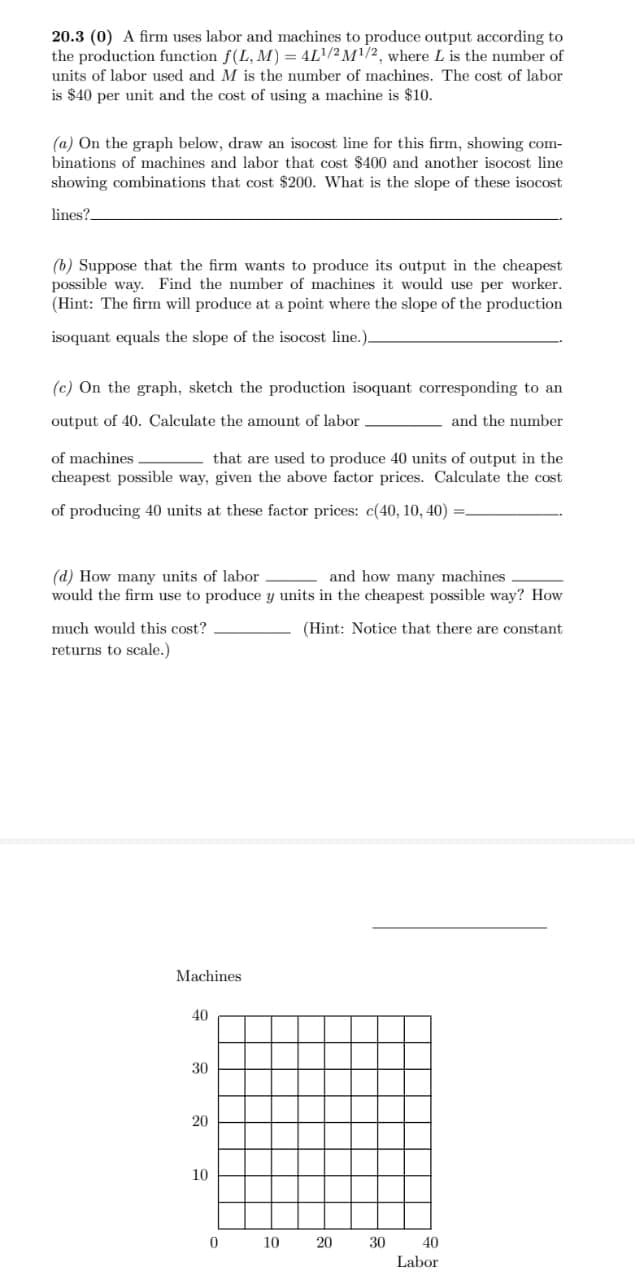20.3 (0) A firm uses labor and machines to produce output according to the production function f(L, M) = 4L?/2 M/2 , where L is the number of units of labor used and M is the number of machines. The cost of labor is $40 per unit and the cost of using a machine is $10.
20.3 (0) A firm uses labor and machines to produce output according to the production function f(L, M) = 4L?/2 M/2 , where L is the number of units of labor used and M is the number of machines. The cost of labor is $40 per unit and the cost of using a machine is $10.
Chapter10: Cost Functions
Section: Chapter Questions
Problem 10.4P
Related questions
Question

Transcribed Image Text:20.3 (0) A firm uses labor and machines to produce output according to
the production function f(L, M) = 4L/2 M/2, where L is the number of
units of labor used and M is the number of machines. The cost of labor
is $40 per unit and the cost of using a machine is $10.
(a) On the graph below, draw an isocost line for this firm, showing com-
binations of machines and labor that cost $400 and another isocost line
showing combinations that cost $200. What is the slope of these isocost
lines?.
(b) Suppose that the firm wants to produce its output in the cheapest
possible way. Find the number of machines it would use per worker.
(Hint: The firm will produce at a point where the slope of the production
isoquant equals the slope of the isocost line.)
(c) On the graph, sketch the production isoquant corresponding to an
output of 40. Calculate the amount of labor
and the number
that are used to produce 40 units of output in the
cheapest possible way, given the above factor prices. Calculate the cost
of machines
of producing 40 units at these factor prices: c(40, 10, 40) =.
(d) How many units of labor
would the firm use to produce y units in the cheapest possible way? How
and how many machines
much would this cost?
(Hint: Notice that there are constant
returns to scale.)
Machines
40
30
10
10
20
30
40
Labor
20
Expert Solution
This question has been solved!
Explore an expertly crafted, step-by-step solution for a thorough understanding of key concepts.
This is a popular solution!
Trending now
This is a popular solution!
Step by step
Solved in 3 steps with 2 images

Knowledge Booster
Learn more about
Need a deep-dive on the concept behind this application? Look no further. Learn more about this topic, economics and related others by exploring similar questions and additional content below.Recommended textbooks for you







Principles of Economics 2e
Economics
ISBN:
9781947172364
Author:
Steven A. Greenlaw; David Shapiro
Publisher:
OpenStax


Microeconomics: Principles & Policy
Economics
ISBN:
9781337794992
Author:
William J. Baumol, Alan S. Blinder, John L. Solow
Publisher:
Cengage Learning